Resultant forces - Study guides, Study notes & Summaries
Looking for the best study guides, study notes and summaries about Resultant forces? On this page you'll find 465 study documents about Resultant forces.
Page 2 out of 465 results
Sort by
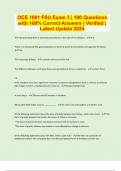
-
OCE 1001 FSU Exam 3 | 100 Questions with 100% Correct Answers | Verified | Latest Update 2024
- Exam (elaborations) • 10 pages • 2024
- Available in package deal
-
- R187,92
- + learn more
The tide-generating force is inversely proportional to the cube of the distance. - True There is no horizontal tide-generating force on Earth at points directly below and opposite the Moon. - True The barycenter follows: - a smooth orbit around the Sun. The difference between centripetal forces and gravitational forces is called the: - resultant force. t A If the resultant force has a significant horizontal component (tangential to Earth's surface), it produces tidal bulges on Earth, cre...
![GCSE AQA [TRIPLE] Physics AQA PSYCHOLOGY PAPER 2 LATEST EXAM 2024 EXPERT CERTIFIED QUESTIONS AND ANSWERS](/docpics/4433210/65c1ea50b55ac_4433210_121_171.jpeg)
-
GCSE AQA [TRIPLE] Physics AQA PSYCHOLOGY PAPER 2 LATEST EXAM 2024 EXPERT CERTIFIED QUESTIONS AND ANSWERS
- Exam (elaborations) • 34 pages • 2024
-
- R322,27
- + learn more
GCSE AQA [TRIPLE] Physics AQA PSYCHOLOGY PAPER 2 LATEST EXAM 2024 EXPERT CERTIFIED QUESTIONS AND ANSWERS Difference between scalar and vector: - CORRECT ANSWER--scalar = magnitude only -vector = direction and magnitude The only vector quantities are: - CORRECT ANSWER-- acceleration -velocity -force -displacement -momentum -weight Force - CORRECT ANSWER--a push or a pull Balanced forces - CORRECT ANSWER--when 2 forces acting on an object are equal in size but act in opposite dire...
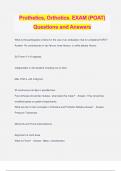
-
Prothetics, Orthotics. EXAM (POAT) Questions and Answers
- Exam (elaborations) • 89 pages • 2024
- Available in package deal
-
- R259,57
- + learn more
Prothetics, Orthotics. EXAM (POAT) Questions and Answers What is the participation criteria for the use of an ambulation trial for a bilateral KAFO? - Answer- No contractures in hip flexors, knee flexors, or ankle plantar flexors SLR from 0-110 degrees Independent in all transfers including w/c to floor Max VO2 is >20 ml/kg/min 50 continuous full dips in parallel bars Foot orthoses should be modular, what does this mean? - Answer- They should be modified based on patient impairments ...
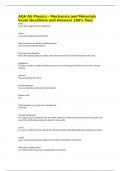
-
AQA AS Physics - Mechanics and Materials Exam Questions and Answers 100% Pass
- Exam (elaborations) • 7 pages • 2024
-
- R191,50
- + learn more
AQA AS Physics - Mechanics and Materials Exam Questions and Answers 100% Pass Scalar A unit with magnitude but no direction. Vector A unit with magnitude and direction. What are the two methods for adding vectors? Scale drawings and trigonometry. Free-body force diagrams Show all the forces acting on a body, each arrow shows the size and the direction of the force. Equilibrium The forces acting on a body are balances and it is not accelerating (it may be at rest or at a...

-
OCE 1001 FSU Exam 3 | 100 Questions with 100% Correct Answers | Verified | Latest Update 2024
- Exam (elaborations) • 10 pages • 2023
- Available in package deal
-
- R223,74
- + learn more
The tide-generating force is inversely proportional to the cube of the distance. - True There is no horizontal tide-generating force on Earth at points directly below and opposite the Moon. - True The barycenter follows: - a smooth orbit around the Sun. The difference between centripetal forces and gravitational forces is called the: - resultant force. t A If the resultant force has a significant horizontal component (tangential to Earth's surface), it produces tidal bulges on Earth, cre...
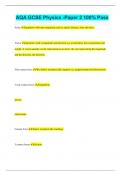
-
AQA GCSE Physics -Paper 2 100% Pass
- Exam (elaborations) • 56 pages • 2023
- Available in package deal
-
- R187,92
- + learn more
AQA GCSE Physics -Paper 2 100% Pass Scalar quantities with only magnitude such as speed, distance, time and mass. Vector quantities with a magnitude and direction e.g. acceleration, force momentum and weight. A vector quantity can be represented as an arrow, the size representing the magnitude and the direction, the direction. Non-contact force the objects are physically separate e.g. magnetism/gravity/electrostatic. 3 non-contact forces magnetism gravity electrostatic Contact force object...

-
Edexcel GCSE Triple Science Physics Paper 2 2024 WITH QUESITIONS AND ANSWERS GRADED A+
- Exam (elaborations) • 26 pages • 2024
-
- R250,61
- + learn more
Edexcel GCSE Triple Science Physics Paper 2 2024 WITH QUESITIONS AND ANSWERS GRADED A+ Difference between scalar and vector: - CORRECT ANSWER--scalar = magnitude only -vector = direction and magnitude The only vector quantities are: - CORRECT ANSWER--acceleration -velocity -force -displacement -momentum -weight Force - CORRECT ANSWER--a push or a pull Balanced forces - CORRECT ANSWER--when 2 forces acting on an object are equal in size but act in opposite direction What is Newton's 1...
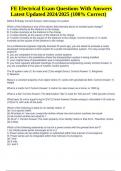
-
FE Electrical Exam Questions With Answers Latest Updated 2024/2025 (100% Correct)
- Exam (elaborations) • 47 pages • 2024
-
- R331,23
- + learn more
FE Electrical Exam Questions With Answers Latest Updated 2024/2025 (100% Correct) Define Enthalpy Correct Answer: total energy of a system Which of the following is true of the electric field intensity about an isolated point charge? A. It varies directly as the distance to the charge. B. It varies inversely as the distance to the charge. C. It varies directly as the square of the distance to the charge. D. It varies inversely as the square of the distance to the charge. Correct Answer: D. ...
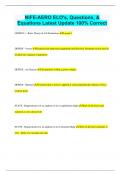
-
NIFE-AERO ELO's, Questions, & Equations Latest Update 100% Correct
- Exam (elaborations) • 18 pages • 2024
- Available in package deal
-
- R178,96
- + learn more
NIFE-AERO ELO's, Questions, & Equations Latest Update 100% Correct LESSON 1 - Basic Theory & Lift Production Lesson 1 DEFINE - Vector Quantity that represents magnitude and direction. Resultant vector may be divided into separate components DEFINE - Air Density Air particles within a given volume. DEFINE - Moment Created when a force is applied at some perpendicular distance from a rotation point STATE - Requirements for an airplane to be in equilibrium flight Sum of all force...
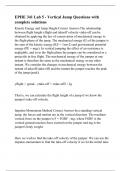
-
EPHE 341 Lab 5 - Vertical Jump Questions with complete solutions
- Exam (elaborations) • 8 pages • 2024
-
- R241,66
- + learn more
Kinetic Energy and Jump Height Correct Answer-The relationship between flight height yflight and takeoff velocity vtake-off can be obtained by applying the law of conservation of mechanical energy to the flight phase of the jump. The mechanical energy (E) of the jumper is the sum of the kinetic energy (KE = ½mv2) and gravitational potential energy (PE = mgy). In vertical jumping the effect of air resistance is negligible, and so in the flight phase the jumper can be considered as a projectile i...

How did he do that? By selling his study notes on Stuvia. Try it yourself! Discover all about earning on Stuvia


